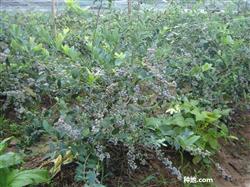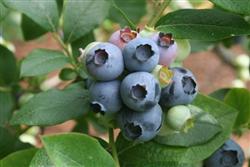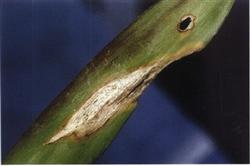How to control diseases and insect pests in blueberry planting?

How to control diseases and insect pests in blueberry planting? Please guide the original fungi, bacteria and viruses that harm blueberries, there are dozens of diseases. The common hazards in production are as follows. (1) Blueberry fungal diseases 1. Blueberry ossified fruit disease is one of the most common and serious diseases in blueberry production. It is caused by Monilina Vaccinii-corybosi fungi. In the early stage of invasion, mature spores germinate on the surface of new leaves and flowers, and hyphae develop in the intracellular and extracellular areas of leaves and flowers, causing cell rupture and death. As a result, new leaves, buds, stems and inflorescences suddenly wilt and turn brown. After 4 weeks, the powdery matter produced by fungal spores covered leaf veins, stem tips and styles, and spread to open flowers for secondary infection, and finally the damaged fruits wilted, dehydrated, dried, shedded, and showed zombie shape. After overwintering, the spores on the fallen fruit germinate and enter the second year cycle again. According to the survey, in the worst years, 70% of blueberries suffer, and in lighter years, it can reach 8% and 10%. The occurrence of stiff fruit disease is related to climate and variety. The disease is often serious in areas with heavy rain and high air temperature in early spring, and serious in areas with long low temperature in winter. Different varieties of blueberries are susceptible to disease. Rabbit-eyed blueberries are susceptible to infection at the initial stage of the disease, while Nelson, Leta, Darrow and Colin are highly resistant, while Lanfeng, Berkeley, Lanle, Zaolan, Jersey and Weikou are susceptible to the disease. The harm of stiff fruit disease can be reduced by variety selection and region selection in production. Before winter, remove the fallen leaves and fruits in the orchard, burn or bury them in the ground, which can effectively reduce the occurrence of stiff fruit disease. Shallow ploughing before flowering in spring and application of urea in soil also help to reduce the occurrence of diseases. Different agents can be used according to different stages of occurrence. Spraying 50% urea in early spring can control the initial stage of the fruit, and spraying 20% azinamide before flowering can control the first and second infection, and the effect can reach more than 90%. Zinamide is the most effective fungicide for the prevention and treatment of blueberry fruit disease. 2. Blueberry stem canker and branch Fusarium wilt are serious diseases in blueberry production in the northeastern United States. It is caused by Phomopsis Vaccinii fungi. The most obvious symptom of stem canker is "wilting", or stem wilting or even death in summer. In severe cases, multiple stems on a plant are damaged. The damaged leaves turn brown in hot weather. As the branches mature, the leaves curl in bundles on the branches. The infection site of stem canker is often located at the base of the branch and is flat. The small black spots of the infection site contain spores. The transmission of spores is mainly scoured by Rain Water. Fusarium wilt often occurs in the annual branches of 5~15cm, and the main symptom is top death. The method of prevention and treatment is to cut off and burn the wilted and discolored branches during the pruning of the dormant apparatus, and cut the diseased branches to the normal parts in summer. In the selection of garden sites, the frost damage in early spring and late spring should be avoided as much as possible, and measures such as weeding, irrigation and fertilization should be adopted to promote branches to mature as soon as possible. Spraying agents for the prevention and treatment of stiff fruit disease can reduce the harm of stem canker. In addition to the above two major fungal diseases, other fungal diseases include leaf spot, root rot, fruit rot and so on. (2) Blueberry virus diseases there are several serious viral diseases in blueberry production. In general, the spread of viral diseases is mainly insects, such as aphids, nematodes, leafhoppers, bees and so on. Once the plant is susceptible to disease, it will endanger the whole life. The best measure of prevention is to give priority to prevention. Once the disease occurs, the susceptible plants should be removed as soon as possible and insecticides should be sprayed at the same time to control the spread of the virus carried by pests. 1. Blueberry scorch virus (BBScV) can cause the death of leaves and flowers. Among Gaocong blueberries, "Lanfeng", "Blue Tower", "Jersey", "Opia" and "Washington" showed disease resistance. Although these varieties showed symptoms when they were infected, they did not cause yield loss. "Berkeley" and "Dixie" showed poor disease resistance and suffered seriously. The first symptom of the damaged plant was in the early spring flowering stage, mainly flower wilting and a small number of death, a small amount of death of the leaves close to the inflorescence, and chlorosis of the leaf margin on the old branches, which occurred every year. With the plant growth, "Dixie" and "Piper" varieties often died of 5~10cm in the upper part of the damaged branches, while "Berkeley" with poor disease resistance often showed most of the leaf death, resulting in the death of 3-6-year-old plants. Some varieties with stronger disease resistance only showed symptoms of leaf chlorosis. Damaged and wilted flowers often fail to develop into fruit, resulting in a decrease in yield. Blueberry scorch blight spreads rapidly in the field. According to a survey in the United States, in a blueberry orchard with 283 "Piper" plants, 50% of the plants can be damaged within a year. The victimization rate was 6% at the time of planting and 95% after 5 years. According to research, its transmission is mainly realized by aphids. The best way to control this disease is to plant virus-free seedlings and when choosing a planting garden, make sure that there is no such virus in the area and adjacent gardens. In particular, it is worth noting that the disease-resistant varieties planted near the blueberry orchard are disease-resistant varieties, which are asymptomatic, but may be susceptible and are permanent sources of disease. Once it is found that the plant is damaged, the burning should be removed immediately, and the aphids should be strictly controlled within 3 years to prevent future disease. 2. Blueberry shoelace virus disease blueberry shoelace virus disease is the most common and serious disease in blueberry production. In 1981, Michigan caused 3 million dollars in economic losses as a result of the disease. The most obvious symptom of the disease is that there are long, narrow, red stripes on the top of the current year-old branch and the one-year-old branch, especially on the light side. At the flowering stage, the petals of the injured plants are purplish red or red, most of the damaged leaves are banded (hence the "shoelace"), and a few leaves are red along the leaf vein or along the midrib. Some leaves turn red in the shape of a crescent moon or all turn red, and the upper part of the damaged branches are often bent. Blueberry shoelace disease spreads from plant to plant, mainly by blueberry aphids. The incubation period of the virus is 4 years, that is, the infected plants show symptoms after 4 years. The use of virus-carrying plants to propagate seedlings is the main way for the virus to spread over a long distance. The most important measure of prevention and control is to put an end to the breeding of diseased plants. When the damaged plants are found in the field, blueberry aphids are strictly controlled with insecticides, and when mechanical harvesting is used, insecticides should be sprayed on mechanical instruments to prevent the spread of virus-carrying aphids. 3. Blueberry leaf spot disease up to now, the occurrence area of blueberry leaf spot disease is less, but once it occurs, it will cause serious harm. Within a few years from the onset of the disease, the stem died until the whole plant died. Different varieties have different resistance to the disease and different symptoms. The disease resistance of "Lubel" was the worst. After 5 or 6 years, the damaged plants showed perennial stem death, dwarf and abnormal growth of new branches, and the leaves were spotted and sometimes withered, showing a rough ring "window". Further development of leaf deformities and strip scorch. The "Jersey" variety showed lighter performance and less stem death, but the tree growth was short. Due to the shortening of internodes, the upper leaves of branches were clustered and yellowish green, and the leaves became smaller than normal leaves. Blueberry leaf spot is mainly spread by the pollination activities of honeybees and bumblebees, and its spread range can reach more than 1km2 according to the activity range of honeybees. In a 10ha orchard, if a plant is infected by the virus, the infection rate can reach more than 50% within 10 years. The use of diseased plants to propagate seedlings is also an important mode of transmission. The best way to prevent and cure the disease is to remove the diseased plant. The use of pesticides prevents bees from pollination, thus affecting yield and quality. The incubation period of blueberry leaf spot is 4 years, so early diagnosis is very important, and ELISA enzyme-linked immunosorbent assay can be used for early diagnosis. In addition, controlling the release of bees in production can also effectively control the spread of the disease, and new orchards should leave the susceptible orchards at least 2km2. 4. Blueberry mosaic disease is a common disease in blueberry production. The occurrence of this disease can reduce the yield loss by 15%. The occurrence of mosaic disease is related to genotypes. for example, the occurrence of mosaic disease in "Convier" varieties is considered to be a physiological disorder caused by genes. The main symptoms of the disease are that the leaves turn yellow-green and yellow with spots or annular scorch, and sometimes purple spots. The distribution of symptoms was spotted on the plants, and the symptoms were different in different years. The symptoms were serious in one year, but not in the next year. Mosaic disease is mainly transmitted by blueberry aphids and virus-carrying seedlings, so the application of insecticides to control aphids and the cultivation of virus-free seedlings can effectively control the occurrence of the virus. 5. Blueberry red wheel spot is one of the most common diseases in blueberry producing areas in the United States. According to the investigation, the occurrence of the disease can cause at least 25% of the production loss. When the plant is infected, the leaves of one-year-old branches often show green wheel-shaped red spots in the middle, and the diameter of the spots is 0.05~0.1cm. In summer and autumn, the upper part of the old leaves also showed this symptom. The virus is mainly transmitted by pink scale, another way is spread by virus-carrying seedlings, and the main way of prevention and control is to use virus-free seedlings. In addition to the above five virus diseases, dwarf virus, tomato red dot virus and goat tail virus all cause harm to blueberry production. Click to get more blueberry planting techniques click to get more fruit planting techniques
- Prev

How to fertilize blueberries?
How to fertilize blueberries? Please introduce the method to fertilize blueberries can refer to the following methods: First, blueberry fertilizer requirements characteristics: Blueberry is a typical calcium-rich plant, when cultivated in calcareous soil often leads to excessive calcium-induced iron deficiency chlorosis. Blueberry belongs to oligotrophic plants, and other fruits...
- Next

How to prevent and cure pineapple stem spot mildew leaf spot?
How to prevent and cure pineapple stem spot mildew leaf spot? What harm does pineapple stem spot mildew leaf spot disease have? Please introduce the harm of pineapple stem spot leaf spot: pineapple stem spot leaf spot is a common disease, which belongs to a kind of leaf spot disease, which mainly harms leaves and affects leaf photosynthesis.
Related
- Moge, come on! The staff of the peasant association in the producing area of cantaloupe were frightened when the crowd gathered.
- Causes and Solutions of low Fruit setting rate of Apple
- Symptoms and control measures of passion fruit virus disease
- Fruit growing lesson: how do apple orchards keep high yields?
- Can you build orchards in the mountains? What are the pros and cons?
- How to manage the coloring period of Crisson grape?
- This paper introduces the processing technology of two kinds of fig products.
- How much is a month for retired teachers in rural areas by 2020?
- How can strawberry planting increase sugar content? We should pay attention to management in many aspects.
- What are the cultivation techniques on how to improve the yield of golden fruit?

